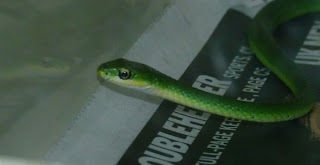 |
| Pygmy Rattle Snake
People have only two reactions when it comes to snakes. Either they fear them or love them. Tavia received responses from many people about our Slithering Snakes Open House today saying they were afraid of snakes and would not attend. I imagine they expect snakes to be giant, poisonous, slimy creatures, much like something you would see in a horror movie. I think snakes have hissss-torically been given a bum rap.
Common Garter Snake
This is probably the best attended Open House we’ve every had, so there must be just as many people who are fascinated by snakes. We tried to convince everyone that we would only have friendly snakes from our expert at Salato Wildlife Center, much like this little smiling Common Garter snake. Snakes have fascinated me since I held one as a child and felt the smooth skin and muscles squeezing my finger.
|
I worked hard to get photos of the snakes with their tongues out. The tongues sample scents (chemicals) in the air, transferring them to an organ in the roof of the snake’s mouth, so the brain can analyze and identify what’s around for lunch.
Some tongues are black, but others are RED, a real surprise to me!
The biologists from Salato brought five non-venomous Kentucky snakes, and we had a Common Garter snake caught on the preserve. Look at this post from another blog about Garter Snake mating! Whoo-hoo! The program was wonderful – full of information about these reptiles. For example, did you know that lizards have closeable eyelides, while snakes do not? We were all impressed at the knowledge the kids already had about snakes, without any prompting from adults at all. Jamie let them touch the snakes – an important thing to help anyone really learn and get enthused about nature.
Most folks probably know that snakes eat mice and rats. This makes them an ally to Kentucky farmers. However, this Black Kingsnake also eats poisonous snakes, being immune to the venom of Kentucky’s pit vipers. We learned that poisonous snakes have vertical pupils in their eyes, while the non-venomous snakes have round pupils. Take a look at the photo of the Pygmy Rattler at the top to see this. (By the way, that snake was stuffed and mounted, not alive, even though it still looks pretty scary.)
I was fascinated by the different patterns on the bellies of these snakes too, which we wouldn’t normally see on a wild snake. What possible role could this play in the survival of these animals?
This Northern Pine snake burrows underground in piney areas, and it’s not very common in Kentucky. Jamie woke it up to come to the program and it was not happy, so he got bit. Even though a snake is non-venomous, it still has teeth and will bite if annoyed or frightened. All the kids knew to look at them and leave them alone if a snake is ever found in the wild.
The Pine Snake’s upper skin is rough, but the bottom felt as smooth as shoe leather. The more senses we can use in observing nature, the more fascinating we find it.










